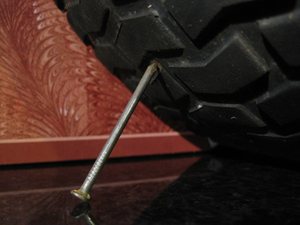
Earlier this week, I had a conversation with a tire specialist. We discussed the issue of flat tires and how to avoid them. This brought me back to a lesson learned earlier in my career.
Years ago, I delivered to a mobile home manufacturer on a regular basis. The parking lot was inundated with nails, screws and other fasteners. To drive away without a flat tire proved to be quite a challenge. One afternoon while making a delivery, I spoke with an older driver and explained my frustration as I was spending way too much money on new tires and repairs. He said to me “I would assume that most of your flat tires are on the rear axle of both your tractor and trailer tandems.” I replied “yes, you’re correct.” He discussed with me that I was driving too fast in their parking lot. I took insult to his accusation and he explained that I was driving in a safe manner, just not slow enough to avoid getting a flat tire.
 |
|
It is hard to just get a nail to stand up on its head. |
So… what does speed have to do with a flat tire? The reason why flat tires are more prevalent on the trailing axle of a tandem is from the lead axle lifting the nail or screw into a position to cause a puncture to the rear tire. After taking his advice, I decided to idle in first gear each time I delivered to this customer. His words of wisdom helped a great deal and I’ve saved numerous tire repair/replacement fees over the years.
Today, I still apply the same tactic to drive very slowly in parking areas where nails and screws tend to be a problem. Every now and then, I’ll get a flat tire however, it is the rare occasion. I’m thankful for this man’s advice years ago.
 |
|
Everything has to line up just right to get a nail to punture a tire. |